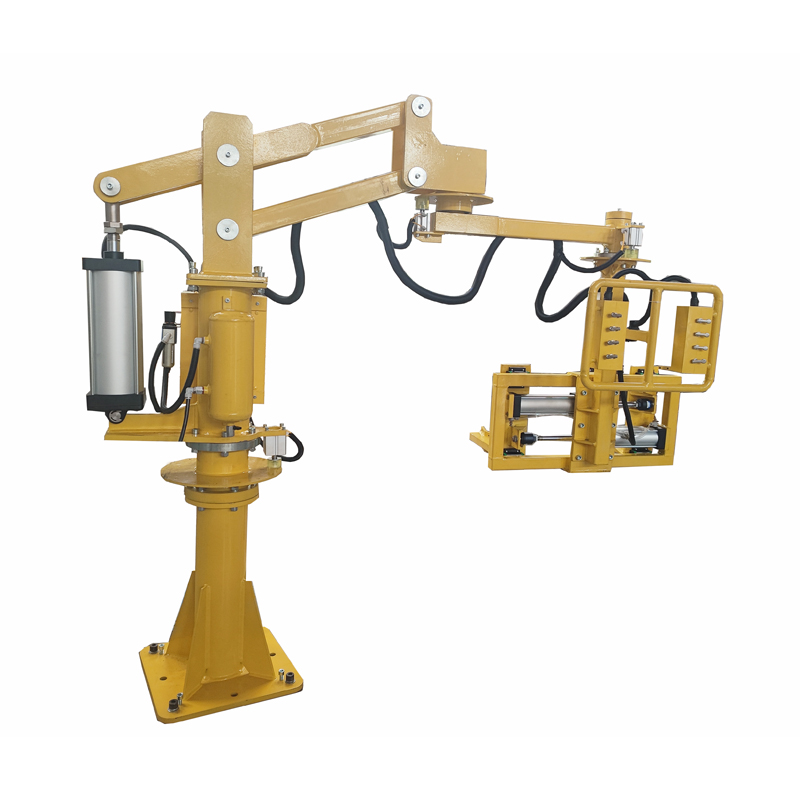In industrial production, power-assisted robots serve as crucial auxiliary equipment, providing effective solutions for optimizing production processes and reducing workload. Tongli Industrial has accumulated extensive experience in the research, development, manufacturing, and application of power-assisted manipulators.
I. Basic Concepts and Working Principles of Power-Assisted Manipulators
A power-assisted manipulator is a mechanical device that allows operators to easily manipulate loads through a balancing mechanism. It typically uses pneumatic, electric, or hydraulic power, employing sensors and a control system to grasp, move, and position objects. Its core principle utilizes force balancing technology, enabling operators to control the robot to handle heavy objects with minimal force.
During operation, the operator guides the manipulator to complete predetermined actions by using a handle or directly pushing the robotic arm. The control system detects the operator’s intentions in real time and drives the actuators to respond accordingly. This design gives power-assisted manipulators significant advantages in repetitive handling and precision assembly scenarios.
II. Technical Features of the Tongli Assisted Manipulator Arm
- In terms of structural design, a modular approach is adopted, allowing for flexible configuration to meet different needs. This design facilitates maintenance and functional expansion while reducing manufacturing complexity.
- Regarding material selection, high-strength aluminum alloys and high-quality steel are primarily used to minimize the equipment’s weight while ensuring structural strength. This material application ensures both durability and operational flexibility.
- Thirdly, the control system utilizes mature industrial-grade components to ensure stable and reliable operation. Through precise sensors and intelligent algorithms, real-time monitoring and accurate control of the load status are achieved. This technical solution makes the operation smoother, reducing vibration and impact during material handling.
III. Application Scenarios of the Assisted Manipulator Arm
Assisted manipulator arms are widely used in various industrial fields. In the automotive manufacturing industry, they are used for assembling heavy components such as engines and transmissions. Operators can easily and accurately position parts weighing hundreds of kilograms to their installation positions, significantly reducing labor intensity.
In the home appliance manufacturing industry, assisted robotic arms are commonly used on production lines for large appliances such as refrigerators and washing machines. It assists workers in tasks such as handling the outer casing and installing internal components, improving production efficiency and operational safety.
In logistics and warehousing, power-assisted robots can help workers handle heavy packages and goods. Through a special end effector design, it can adapt to goods of different shapes and sizes, enabling fast and safe loading and unloading operations.
IV. Precautions for Using Power-Assisted Manipulator
- Several aspects need attention when using power-assisted robots. First, daily maintenance of the equipment is crucial. Regularly check the integrity of the pneumatic, electrical, and mechanical structures, promptly identifying and addressing potential problems. Keeping the equipment clean and lubricated helps extend its service life.
- Second, operator training is essential. Although the operation of power-assisted robots is relatively simple, systematic training is still necessary to familiarize users with the equipment’s performance and operating procedures. Correct usage not only improves work efficiency but also prevents equipment damage caused by misoperation.
- Third, managing the working environment is vital. Ensure the equipment’s working area is clean and orderly, avoiding clutter that could interfere with operation. Pay attention to environmental parameters such as temperature, humidity, and dust concentration, ensuring they are within the equipment’s permissible range.
V. Future Development Trends
With the advancement of industrial technology, the development of assistive manipulator arms is showing several new trends. Increased intelligence is a clear trend, with the application of more sensors and advanced algorithms enabling the equipment to adapt to more complex work scenarios.
Enhanced human-machine collaboration is also an important development trend. The next generation of assistive robotic arms will place greater emphasis on the interactive experience with the operator, making collaboration more natural and fluid through more precise force feedback and more intuitive control methods.
Modular design concepts will be further deepened. Through the application of standardized interfaces and universal components, users can more easily adjust equipment functions according to their needs, reducing usage and maintenance costs.
Improvements in safety are also continuously advancing. New safety protection devices and emergency response mechanisms enable the equipment to react promptly in abnormal situations, ensuring the safety of personnel and equipment.
Post time: Nov-17-2025


